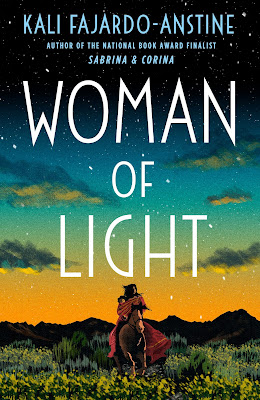Luz “Little Light” Lopez, a tea leaf reader and laundress, is left to fend for herself after her older brother, Diego, a snake charmer and factory worker, is run out of town by a violent white mob. As Luz navigates 1930s Denver, she begins to have visions that transport her to her Indigenous homeland in the nearby Lost Territory. Luz recollects her ancestors’ origins, how her family flourished, and how they were threatened. She bears witness to the sinister forces that have devastated her people and their homelands for generations. In the end, it is up to Luz to save her family stories from disappearing into oblivion.
Amazon affiliate links are used on this site. A free book was provided for an honest review.
 |
I've been making an effort to read more historical fiction about times, places, or events that I'm not as familiar with. Woman of Light covers three time periods: 1905, 1922, and the 1930s. While I've read books about the Depression and Dust Bowl (1930s) and prohibition (1920s) and some turn of the century stories (1900s), I have read very little about the Mexican-Indian Americans of the west.
The book made me look-up the Mexican-American War. Actually it was the term "the Lost Territory" that the characters kept using that led me to the Mexican-American War. I realized outside of the Alamo (I guess I do "remember the Alamo), I don't remember much about the war. And definitely was not aware of the repercussions of the war.
For others who might not know, the Lost Terriotry is the land that Mexico ceded to the U.S. at the end of the Mexican-American war. It included what is today California, Nevada, Utah, the western half of New Mexico, the western quarter of Colorado, and the southwest corner of Wyoming.
The story mostly takes place in Denver in the 1930s but we see the life of Luz's grandmother in the late 1800s-1905 and how Luz's aunt Maria Josie came to Denver in the 1920s.
Probably because I live in the South, most race issues involve African Americans. In the western states where people of Mexican and Native American descent faced similar discrimination. '
Fajardo-Anstine used her own family history and stories in the book. And they are captivating stories.
This is the first book I've read Fajardo-Anstine, and I love her writing style. The characters are great. Though on the surface I have very little income with the characters (I'm white, middle-class, living in an entirely different century) I immediately connected with them and wanted to see their lives improve.
I love learning about their history and culture. I had trouble putting the book down. I wanted to know more about their lives and just spend time with them.
The Dust Bowl and the Depression aren't exactly mentioned but you can see the effects of these events on their lives. Luz's brother Diego becomes a migrant farm worker in California and through the other characters in Luz's life, we learn how men are being forcefully removed from these migrant camps and "returned" to Mexico even though the are U.S. citizens.
I think I read about this in The Grapes of Wrath but it might have been another Dustbowl era novel. But I assumed the men they were removing were Mexican citizens - that they had crossed the border as migrant workers as many do today. However, now I'm wondering if they were just of Mexican descent.
If you haven't read this book, you really should. Not only is it entertaining but it is also eye-opening to a culture and a history I knew very little about.
Buy Woman of Light at Amazon
Donna Huber is an avid reader and natural encourager. She is the founder of Girl Who Reads and the author of how-to marketing book Secrets to a Successful Blog Tour.
Enjoyed this post? Never miss out on future posts by following us. Get even more book news in your inbox, sign up for our newsletter today! Or Follow Girl Who Reads with Bloglovin. Girl Who Reads is an Amazon advertising affiliate; a small commission is earned when purchases are made at Amazon using any Amazon links on this site. Thank you for supporting Girl Who Reads.




.png)
















I'd love reading about a tea-reader reader, and I know I'd love reading life in Denver in the 30s, not to mention life in the 1800s. This book is going on my TBR. Thanks for the suggestion. So many of the books you've suggested I read there already sitting on my kendo or a sample of them is. I'm excited to have more reading time.
ReplyDelete